BUACC 5930: Wesfarmers Retail Financial & Sustainability Report
VerifiedAdded on 2023/06/11
|12
|2706
|288
Report
AI Summary
This report provides a detailed analysis of Wesfarmers' retail businesses, including Coles, Home Improvement, Department Stores, and Officeworks, comparing their financial performance from 2016 to 2017 based on the company's annual report. It examines revenue, gross margin, profitability, return on capital employed (ROCE), and total assets turnover for each division. The report also assesses the sustainability initiatives implemented across these divisions, focusing on energy efficiency, waste recycling, and sustainable agriculture, and ranks their sustainability efforts. The analysis reveals varying performance levels among the divisions, with insights into factors driving their financial results and sustainability practices. Desklib offers a range of similar solved assignments and past papers for students.
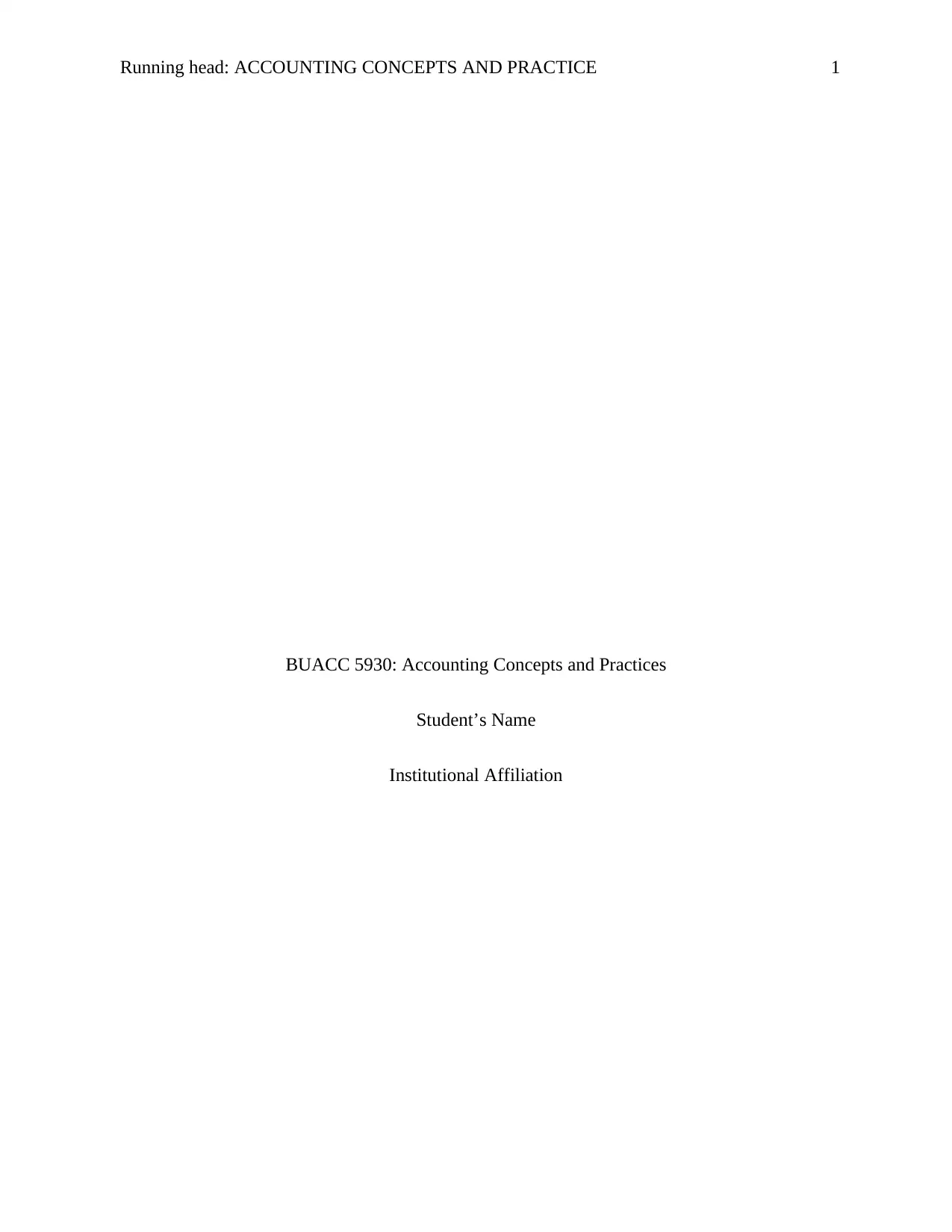
Running head: ACCOUNTING CONCEPTS AND PRACTICE 1
BUACC 5930: Accounting Concepts and Practices
Student’s Name
Institutional Affiliation
BUACC 5930: Accounting Concepts and Practices
Student’s Name
Institutional Affiliation
Paraphrase This Document
Need a fresh take? Get an instant paraphrase of this document with our AI Paraphraser
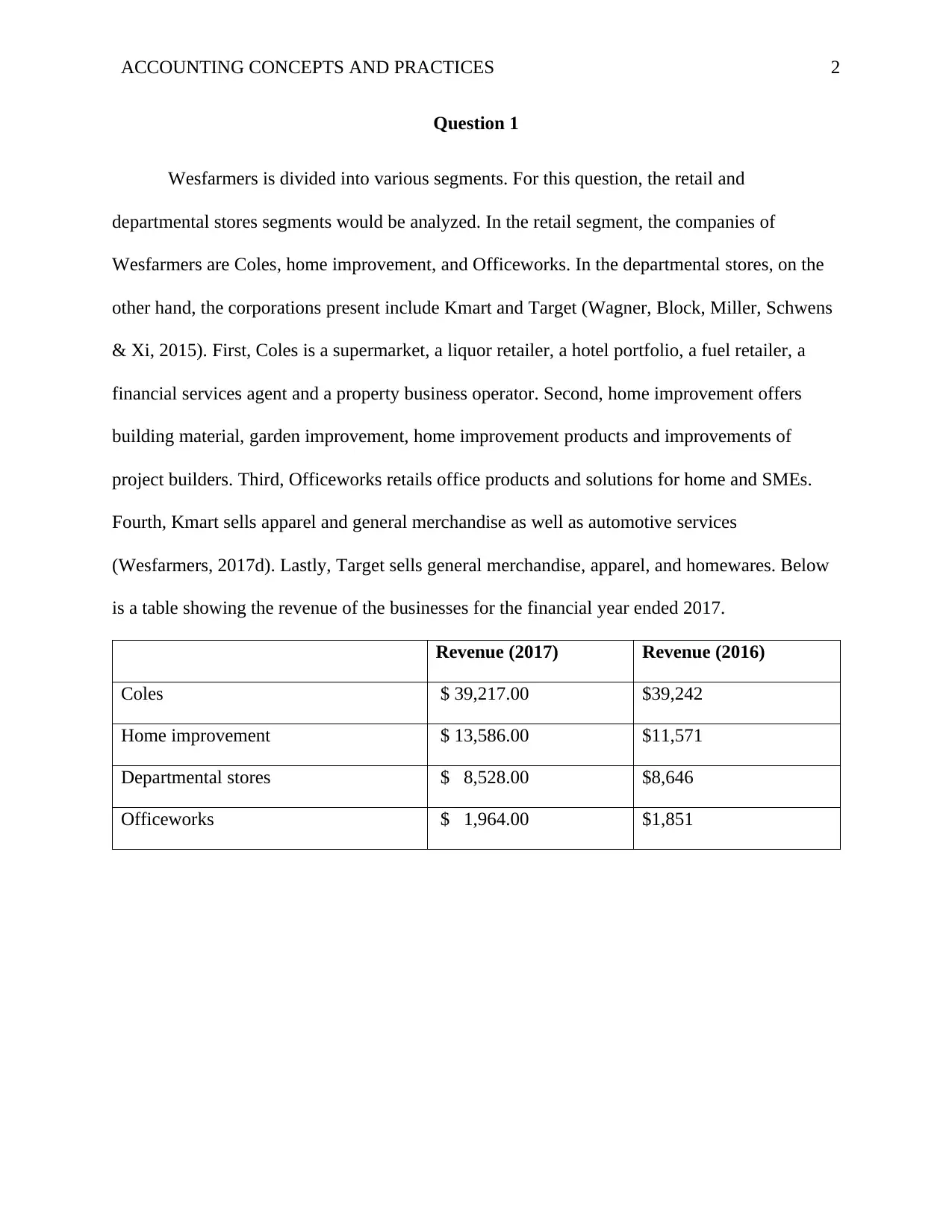
ACCOUNTING CONCEPTS AND PRACTICES 2
Question 1
Wesfarmers is divided into various segments. For this question, the retail and
departmental stores segments would be analyzed. In the retail segment, the companies of
Wesfarmers are Coles, home improvement, and Officeworks. In the departmental stores, on the
other hand, the corporations present include Kmart and Target (Wagner, Block, Miller, Schwens
& Xi, 2015). First, Coles is a supermarket, a liquor retailer, a hotel portfolio, a fuel retailer, a
financial services agent and a property business operator. Second, home improvement offers
building material, garden improvement, home improvement products and improvements of
project builders. Third, Officeworks retails office products and solutions for home and SMEs.
Fourth, Kmart sells apparel and general merchandise as well as automotive services
(Wesfarmers, 2017d). Lastly, Target sells general merchandise, apparel, and homewares. Below
is a table showing the revenue of the businesses for the financial year ended 2017.
Revenue (2017) Revenue (2016)
Coles $ 39,217.00 $39,242
Home improvement $ 13,586.00 $11,571
Departmental stores $ 8,528.00 $8,646
Officeworks $ 1,964.00 $1,851
Question 1
Wesfarmers is divided into various segments. For this question, the retail and
departmental stores segments would be analyzed. In the retail segment, the companies of
Wesfarmers are Coles, home improvement, and Officeworks. In the departmental stores, on the
other hand, the corporations present include Kmart and Target (Wagner, Block, Miller, Schwens
& Xi, 2015). First, Coles is a supermarket, a liquor retailer, a hotel portfolio, a fuel retailer, a
financial services agent and a property business operator. Second, home improvement offers
building material, garden improvement, home improvement products and improvements of
project builders. Third, Officeworks retails office products and solutions for home and SMEs.
Fourth, Kmart sells apparel and general merchandise as well as automotive services
(Wesfarmers, 2017d). Lastly, Target sells general merchandise, apparel, and homewares. Below
is a table showing the revenue of the businesses for the financial year ended 2017.
Revenue (2017) Revenue (2016)
Coles $ 39,217.00 $39,242
Home improvement $ 13,586.00 $11,571
Departmental stores $ 8,528.00 $8,646
Officeworks $ 1,964.00 $1,851
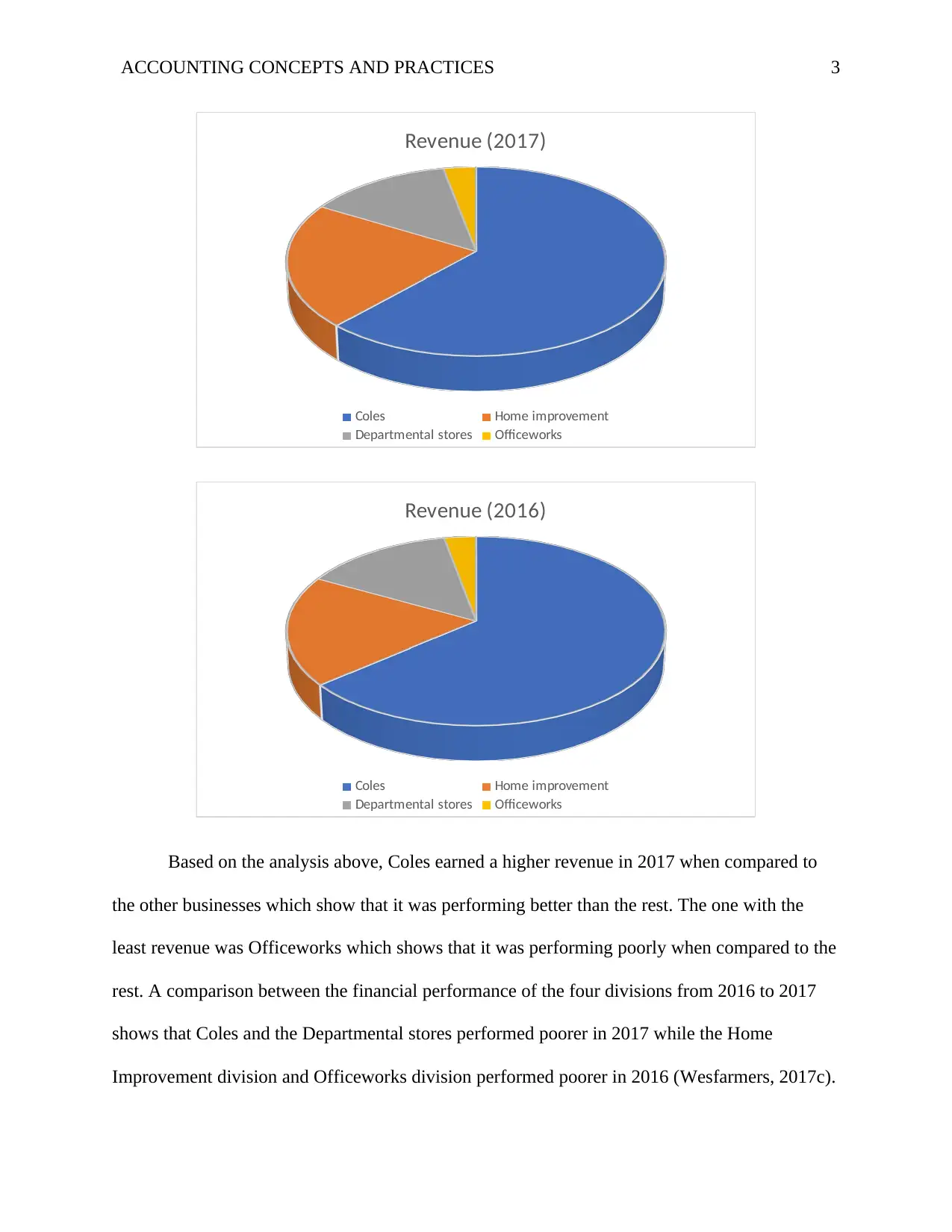
ACCOUNTING CONCEPTS AND PRACTICES 3
Revenue (2017)
Coles Home improvement
Departmental stores Officeworks
Revenue (2016)
Coles Home improvement
Departmental stores Officeworks
Based on the analysis above, Coles earned a higher revenue in 2017 when compared to
the other businesses which show that it was performing better than the rest. The one with the
least revenue was Officeworks which shows that it was performing poorly when compared to the
rest. A comparison between the financial performance of the four divisions from 2016 to 2017
shows that Coles and the Departmental stores performed poorer in 2017 while the Home
Improvement division and Officeworks division performed poorer in 2016 (Wesfarmers, 2017c).
Revenue (2017)
Coles Home improvement
Departmental stores Officeworks
Revenue (2016)
Coles Home improvement
Departmental stores Officeworks
Based on the analysis above, Coles earned a higher revenue in 2017 when compared to
the other businesses which show that it was performing better than the rest. The one with the
least revenue was Officeworks which shows that it was performing poorly when compared to the
rest. A comparison between the financial performance of the four divisions from 2016 to 2017
shows that Coles and the Departmental stores performed poorer in 2017 while the Home
Improvement division and Officeworks division performed poorer in 2016 (Wesfarmers, 2017c).
⊘ This is a preview!⊘
Do you want full access?
Subscribe today to unlock all pages.

Trusted by 1+ million students worldwide
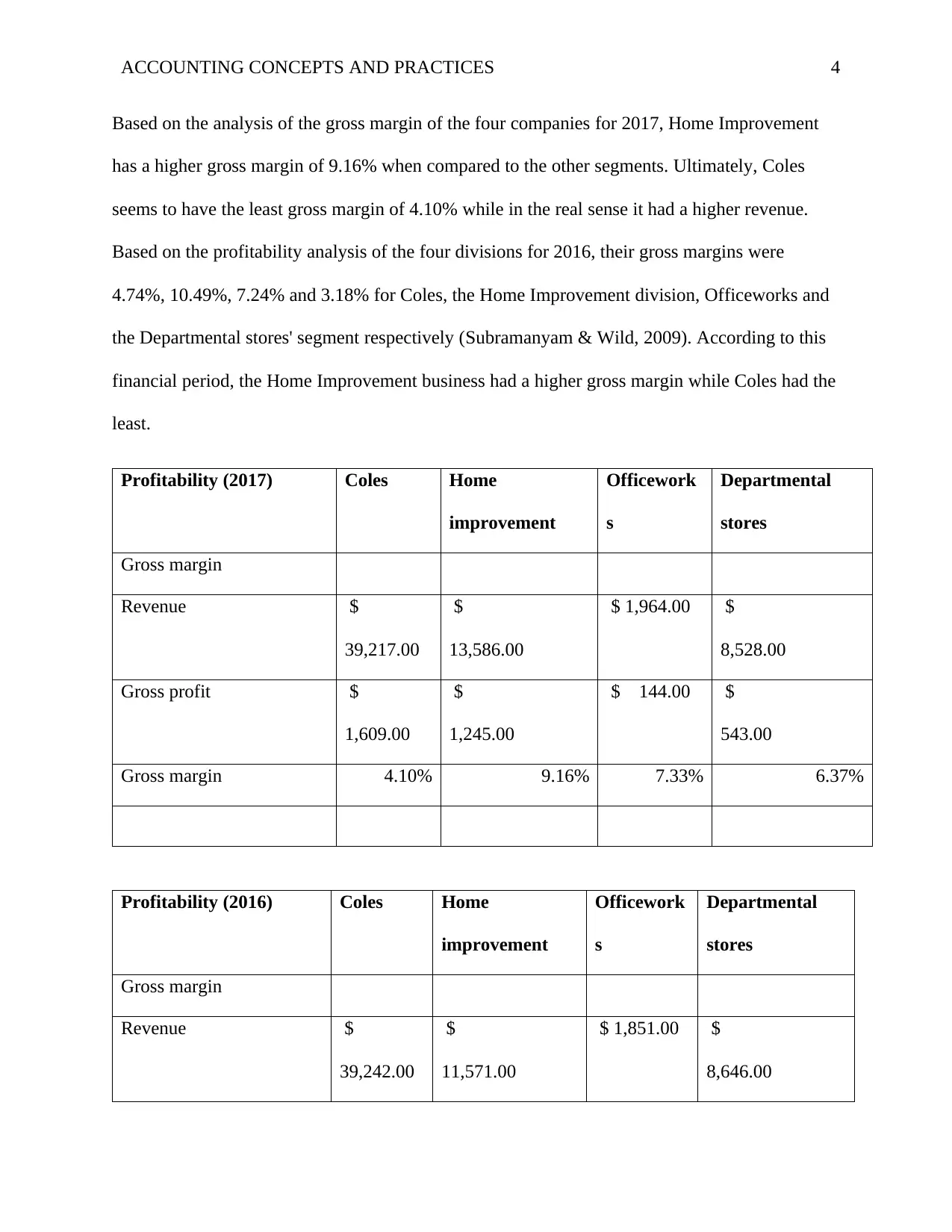
ACCOUNTING CONCEPTS AND PRACTICES 4
Based on the analysis of the gross margin of the four companies for 2017, Home Improvement
has a higher gross margin of 9.16% when compared to the other segments. Ultimately, Coles
seems to have the least gross margin of 4.10% while in the real sense it had a higher revenue.
Based on the profitability analysis of the four divisions for 2016, their gross margins were
4.74%, 10.49%, 7.24% and 3.18% for Coles, the Home Improvement division, Officeworks and
the Departmental stores' segment respectively (Subramanyam & Wild, 2009). According to this
financial period, the Home Improvement business had a higher gross margin while Coles had the
least.
Profitability (2017) Coles Home
improvement
Officework
s
Departmental
stores
Gross margin
Revenue $
39,217.00
$
13,586.00
$ 1,964.00 $
8,528.00
Gross profit $
1,609.00
$
1,245.00
$ 144.00 $
543.00
Gross margin 4.10% 9.16% 7.33% 6.37%
Profitability (2016) Coles Home
improvement
Officework
s
Departmental
stores
Gross margin
Revenue $
39,242.00
$
11,571.00
$ 1,851.00 $
8,646.00
Based on the analysis of the gross margin of the four companies for 2017, Home Improvement
has a higher gross margin of 9.16% when compared to the other segments. Ultimately, Coles
seems to have the least gross margin of 4.10% while in the real sense it had a higher revenue.
Based on the profitability analysis of the four divisions for 2016, their gross margins were
4.74%, 10.49%, 7.24% and 3.18% for Coles, the Home Improvement division, Officeworks and
the Departmental stores' segment respectively (Subramanyam & Wild, 2009). According to this
financial period, the Home Improvement business had a higher gross margin while Coles had the
least.
Profitability (2017) Coles Home
improvement
Officework
s
Departmental
stores
Gross margin
Revenue $
39,217.00
$
13,586.00
$ 1,964.00 $
8,528.00
Gross profit $
1,609.00
$
1,245.00
$ 144.00 $
543.00
Gross margin 4.10% 9.16% 7.33% 6.37%
Profitability (2016) Coles Home
improvement
Officework
s
Departmental
stores
Gross margin
Revenue $
39,242.00
$
11,571.00
$ 1,851.00 $
8,646.00
Paraphrase This Document
Need a fresh take? Get an instant paraphrase of this document with our AI Paraphraser
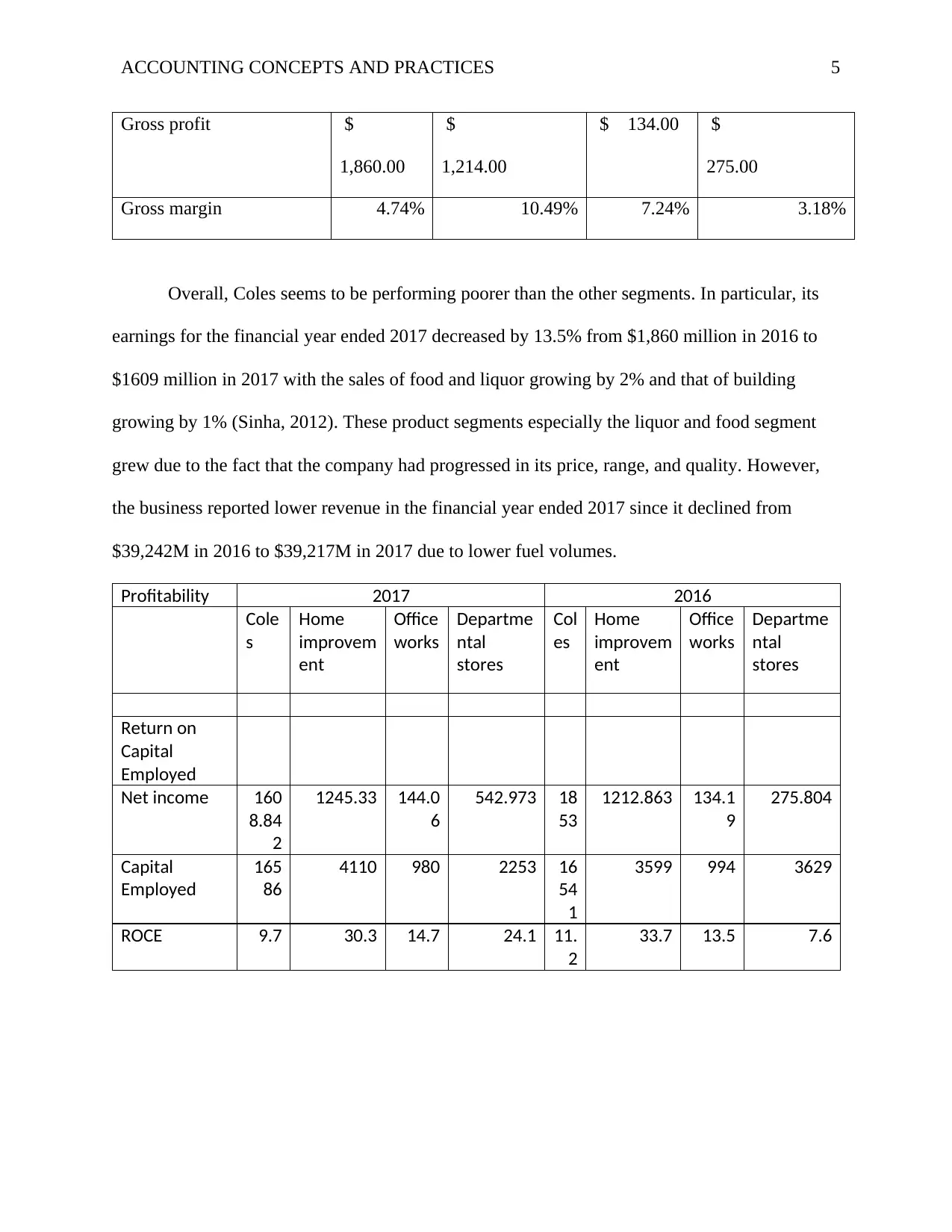
ACCOUNTING CONCEPTS AND PRACTICES 5
Gross profit $
1,860.00
$
1,214.00
$ 134.00 $
275.00
Gross margin 4.74% 10.49% 7.24% 3.18%
Overall, Coles seems to be performing poorer than the other segments. In particular, its
earnings for the financial year ended 2017 decreased by 13.5% from $1,860 million in 2016 to
$1609 million in 2017 with the sales of food and liquor growing by 2% and that of building
growing by 1% (Sinha, 2012). These product segments especially the liquor and food segment
grew due to the fact that the company had progressed in its price, range, and quality. However,
the business reported lower revenue in the financial year ended 2017 since it declined from
$39,242M in 2016 to $39,217M in 2017 due to lower fuel volumes.
Profitability 2017 2016
Cole
s
Home
improvem
ent
Office
works
Departme
ntal
stores
Col
es
Home
improvem
ent
Office
works
Departme
ntal
stores
Return on
Capital
Employed
Net income 160
8.84
2
1245.33 144.0
6
542.973 18
53
1212.863 134.1
9
275.804
Capital
Employed
165
86
4110 980 2253 16
54
1
3599 994 3629
ROCE 9.7 30.3 14.7 24.1 11.
2
33.7 13.5 7.6
Gross profit $
1,860.00
$
1,214.00
$ 134.00 $
275.00
Gross margin 4.74% 10.49% 7.24% 3.18%
Overall, Coles seems to be performing poorer than the other segments. In particular, its
earnings for the financial year ended 2017 decreased by 13.5% from $1,860 million in 2016 to
$1609 million in 2017 with the sales of food and liquor growing by 2% and that of building
growing by 1% (Sinha, 2012). These product segments especially the liquor and food segment
grew due to the fact that the company had progressed in its price, range, and quality. However,
the business reported lower revenue in the financial year ended 2017 since it declined from
$39,242M in 2016 to $39,217M in 2017 due to lower fuel volumes.
Profitability 2017 2016
Cole
s
Home
improvem
ent
Office
works
Departme
ntal
stores
Col
es
Home
improvem
ent
Office
works
Departme
ntal
stores
Return on
Capital
Employed
Net income 160
8.84
2
1245.33 144.0
6
542.973 18
53
1212.863 134.1
9
275.804
Capital
Employed
165
86
4110 980 2253 16
54
1
3599 994 3629
ROCE 9.7 30.3 14.7 24.1 11.
2
33.7 13.5 7.6
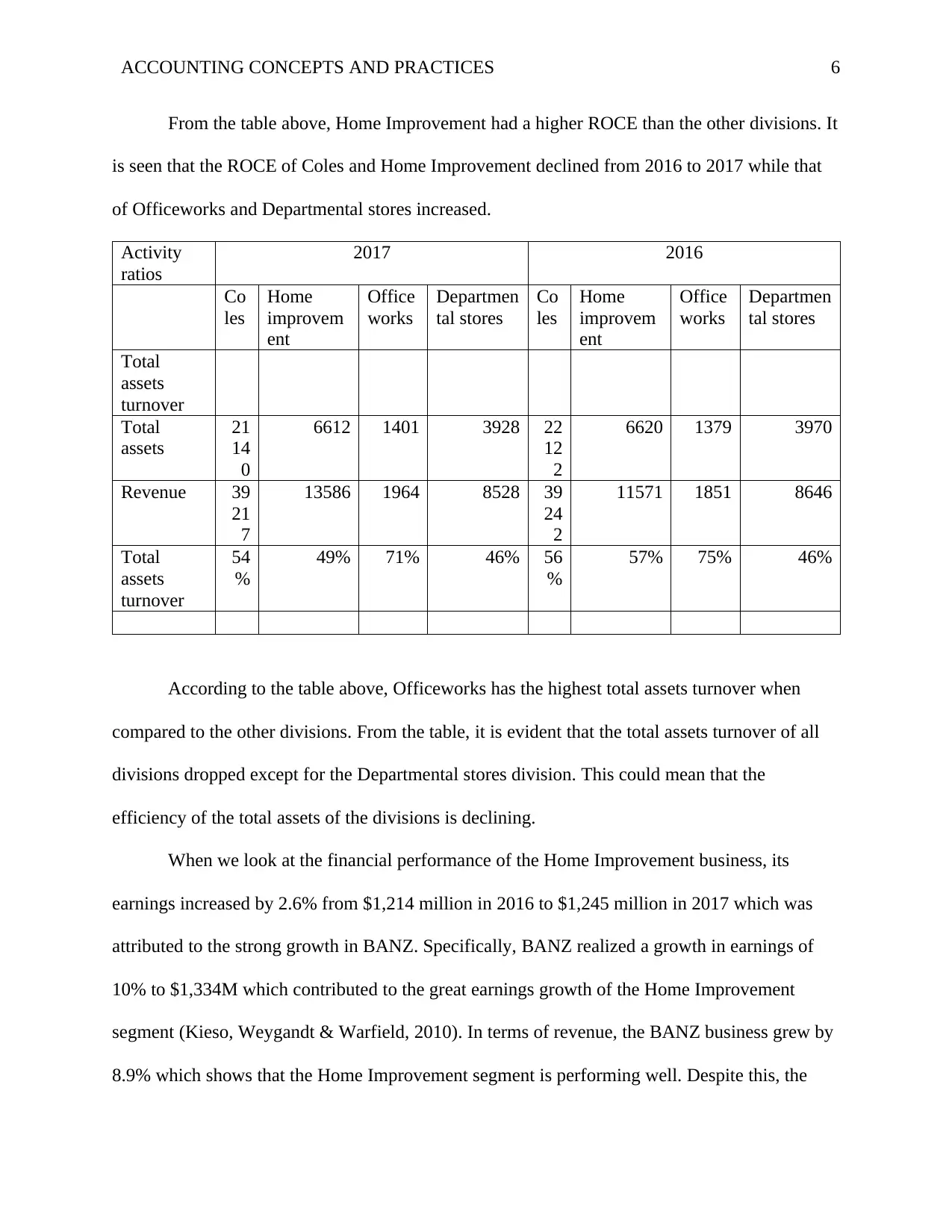
ACCOUNTING CONCEPTS AND PRACTICES 6
From the table above, Home Improvement had a higher ROCE than the other divisions. It
is seen that the ROCE of Coles and Home Improvement declined from 2016 to 2017 while that
of Officeworks and Departmental stores increased.
Activity
ratios
2017 2016
Co
les
Home
improvem
ent
Office
works
Departmen
tal stores
Co
les
Home
improvem
ent
Office
works
Departmen
tal stores
Total
assets
turnover
Total
assets
21
14
0
6612 1401 3928 22
12
2
6620 1379 3970
Revenue 39
21
7
13586 1964 8528 39
24
2
11571 1851 8646
Total
assets
turnover
54
%
49% 71% 46% 56
%
57% 75% 46%
According to the table above, Officeworks has the highest total assets turnover when
compared to the other divisions. From the table, it is evident that the total assets turnover of all
divisions dropped except for the Departmental stores division. This could mean that the
efficiency of the total assets of the divisions is declining.
When we look at the financial performance of the Home Improvement business, its
earnings increased by 2.6% from $1,214 million in 2016 to $1,245 million in 2017 which was
attributed to the strong growth in BANZ. Specifically, BANZ realized a growth in earnings of
10% to $1,334M which contributed to the great earnings growth of the Home Improvement
segment (Kieso, Weygandt & Warfield, 2010). In terms of revenue, the BANZ business grew by
8.9% which shows that the Home Improvement segment is performing well. Despite this, the
From the table above, Home Improvement had a higher ROCE than the other divisions. It
is seen that the ROCE of Coles and Home Improvement declined from 2016 to 2017 while that
of Officeworks and Departmental stores increased.
Activity
ratios
2017 2016
Co
les
Home
improvem
ent
Office
works
Departmen
tal stores
Co
les
Home
improvem
ent
Office
works
Departmen
tal stores
Total
assets
turnover
Total
assets
21
14
0
6612 1401 3928 22
12
2
6620 1379 3970
Revenue 39
21
7
13586 1964 8528 39
24
2
11571 1851 8646
Total
assets
turnover
54
%
49% 71% 46% 56
%
57% 75% 46%
According to the table above, Officeworks has the highest total assets turnover when
compared to the other divisions. From the table, it is evident that the total assets turnover of all
divisions dropped except for the Departmental stores division. This could mean that the
efficiency of the total assets of the divisions is declining.
When we look at the financial performance of the Home Improvement business, its
earnings increased by 2.6% from $1,214 million in 2016 to $1,245 million in 2017 which was
attributed to the strong growth in BANZ. Specifically, BANZ realized a growth in earnings of
10% to $1,334M which contributed to the great earnings growth of the Home Improvement
segment (Kieso, Weygandt & Warfield, 2010). In terms of revenue, the BANZ business grew by
8.9% which shows that the Home Improvement segment is performing well. Despite this, the
⊘ This is a preview!⊘
Do you want full access?
Subscribe today to unlock all pages.

Trusted by 1+ million students worldwide
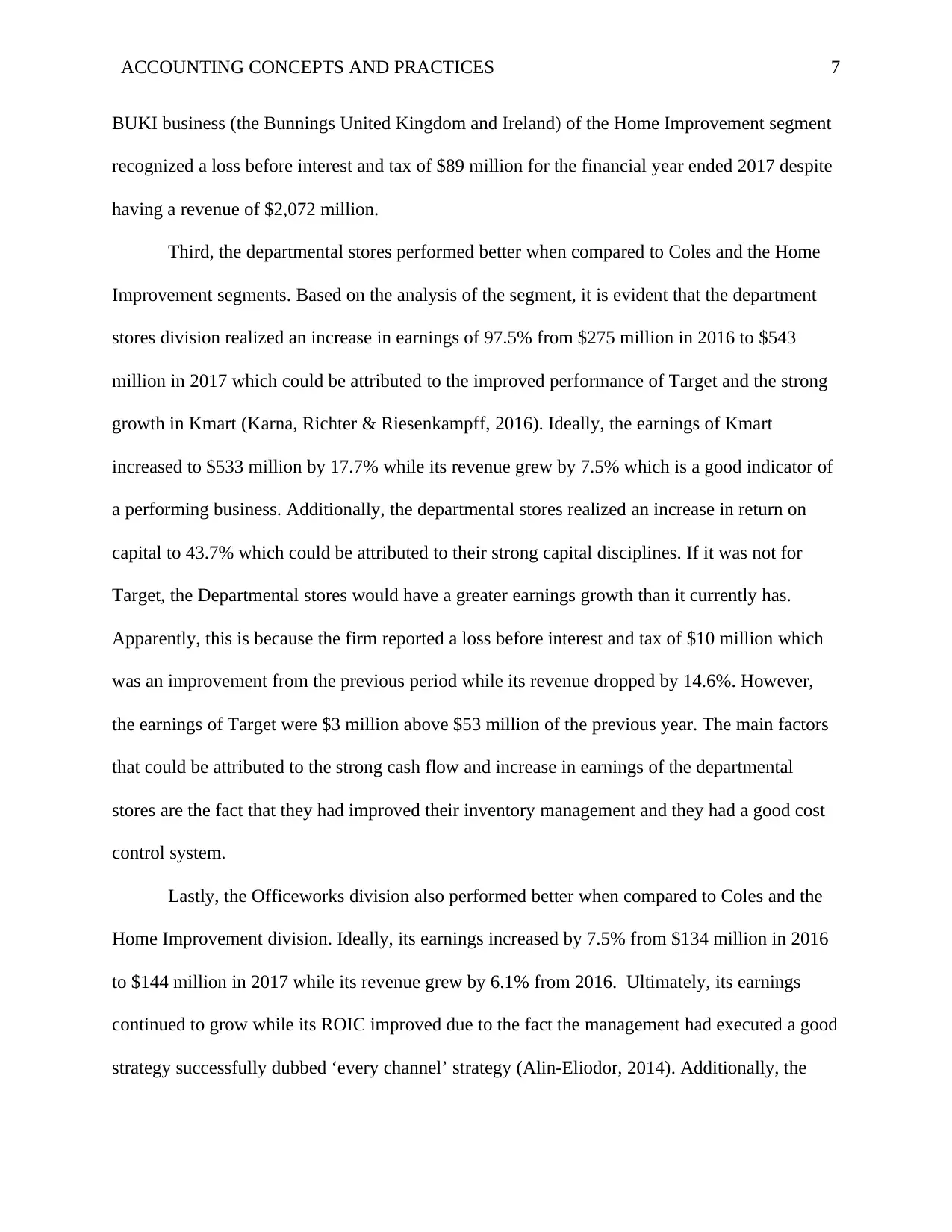
ACCOUNTING CONCEPTS AND PRACTICES 7
BUKI business (the Bunnings United Kingdom and Ireland) of the Home Improvement segment
recognized a loss before interest and tax of $89 million for the financial year ended 2017 despite
having a revenue of $2,072 million.
Third, the departmental stores performed better when compared to Coles and the Home
Improvement segments. Based on the analysis of the segment, it is evident that the department
stores division realized an increase in earnings of 97.5% from $275 million in 2016 to $543
million in 2017 which could be attributed to the improved performance of Target and the strong
growth in Kmart (Karna, Richter & Riesenkampff, 2016). Ideally, the earnings of Kmart
increased to $533 million by 17.7% while its revenue grew by 7.5% which is a good indicator of
a performing business. Additionally, the departmental stores realized an increase in return on
capital to 43.7% which could be attributed to their strong capital disciplines. If it was not for
Target, the Departmental stores would have a greater earnings growth than it currently has.
Apparently, this is because the firm reported a loss before interest and tax of $10 million which
was an improvement from the previous period while its revenue dropped by 14.6%. However,
the earnings of Target were $3 million above $53 million of the previous year. The main factors
that could be attributed to the strong cash flow and increase in earnings of the departmental
stores are the fact that they had improved their inventory management and they had a good cost
control system.
Lastly, the Officeworks division also performed better when compared to Coles and the
Home Improvement division. Ideally, its earnings increased by 7.5% from $134 million in 2016
to $144 million in 2017 while its revenue grew by 6.1% from 2016. Ultimately, its earnings
continued to grow while its ROIC improved due to the fact the management had executed a good
strategy successfully dubbed ‘every channel’ strategy (Alin-Eliodor, 2014). Additionally, the
BUKI business (the Bunnings United Kingdom and Ireland) of the Home Improvement segment
recognized a loss before interest and tax of $89 million for the financial year ended 2017 despite
having a revenue of $2,072 million.
Third, the departmental stores performed better when compared to Coles and the Home
Improvement segments. Based on the analysis of the segment, it is evident that the department
stores division realized an increase in earnings of 97.5% from $275 million in 2016 to $543
million in 2017 which could be attributed to the improved performance of Target and the strong
growth in Kmart (Karna, Richter & Riesenkampff, 2016). Ideally, the earnings of Kmart
increased to $533 million by 17.7% while its revenue grew by 7.5% which is a good indicator of
a performing business. Additionally, the departmental stores realized an increase in return on
capital to 43.7% which could be attributed to their strong capital disciplines. If it was not for
Target, the Departmental stores would have a greater earnings growth than it currently has.
Apparently, this is because the firm reported a loss before interest and tax of $10 million which
was an improvement from the previous period while its revenue dropped by 14.6%. However,
the earnings of Target were $3 million above $53 million of the previous year. The main factors
that could be attributed to the strong cash flow and increase in earnings of the departmental
stores are the fact that they had improved their inventory management and they had a good cost
control system.
Lastly, the Officeworks division also performed better when compared to Coles and the
Home Improvement division. Ideally, its earnings increased by 7.5% from $134 million in 2016
to $144 million in 2017 while its revenue grew by 6.1% from 2016. Ultimately, its earnings
continued to grow while its ROIC improved due to the fact the management had executed a good
strategy successfully dubbed ‘every channel’ strategy (Alin-Eliodor, 2014). Additionally, the
Paraphrase This Document
Need a fresh take? Get an instant paraphrase of this document with our AI Paraphraser
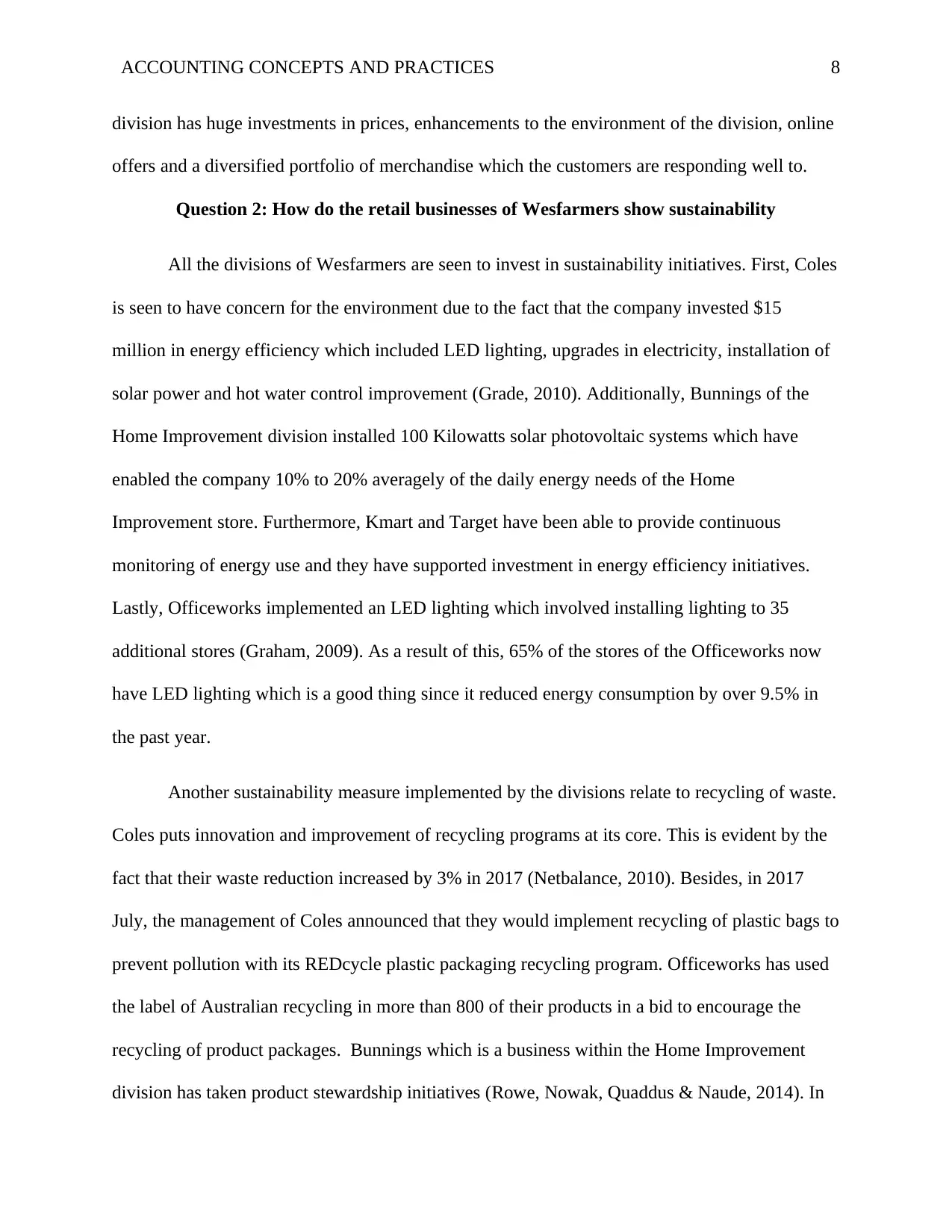
ACCOUNTING CONCEPTS AND PRACTICES 8
division has huge investments in prices, enhancements to the environment of the division, online
offers and a diversified portfolio of merchandise which the customers are responding well to.
Question 2: How do the retail businesses of Wesfarmers show sustainability
All the divisions of Wesfarmers are seen to invest in sustainability initiatives. First, Coles
is seen to have concern for the environment due to the fact that the company invested $15
million in energy efficiency which included LED lighting, upgrades in electricity, installation of
solar power and hot water control improvement (Grade, 2010). Additionally, Bunnings of the
Home Improvement division installed 100 Kilowatts solar photovoltaic systems which have
enabled the company 10% to 20% averagely of the daily energy needs of the Home
Improvement store. Furthermore, Kmart and Target have been able to provide continuous
monitoring of energy use and they have supported investment in energy efficiency initiatives.
Lastly, Officeworks implemented an LED lighting which involved installing lighting to 35
additional stores (Graham, 2009). As a result of this, 65% of the stores of the Officeworks now
have LED lighting which is a good thing since it reduced energy consumption by over 9.5% in
the past year.
Another sustainability measure implemented by the divisions relate to recycling of waste.
Coles puts innovation and improvement of recycling programs at its core. This is evident by the
fact that their waste reduction increased by 3% in 2017 (Netbalance, 2010). Besides, in 2017
July, the management of Coles announced that they would implement recycling of plastic bags to
prevent pollution with its REDcycle plastic packaging recycling program. Officeworks has used
the label of Australian recycling in more than 800 of their products in a bid to encourage the
recycling of product packages. Bunnings which is a business within the Home Improvement
division has taken product stewardship initiatives (Rowe, Nowak, Quaddus & Naude, 2014). In
division has huge investments in prices, enhancements to the environment of the division, online
offers and a diversified portfolio of merchandise which the customers are responding well to.
Question 2: How do the retail businesses of Wesfarmers show sustainability
All the divisions of Wesfarmers are seen to invest in sustainability initiatives. First, Coles
is seen to have concern for the environment due to the fact that the company invested $15
million in energy efficiency which included LED lighting, upgrades in electricity, installation of
solar power and hot water control improvement (Grade, 2010). Additionally, Bunnings of the
Home Improvement division installed 100 Kilowatts solar photovoltaic systems which have
enabled the company 10% to 20% averagely of the daily energy needs of the Home
Improvement store. Furthermore, Kmart and Target have been able to provide continuous
monitoring of energy use and they have supported investment in energy efficiency initiatives.
Lastly, Officeworks implemented an LED lighting which involved installing lighting to 35
additional stores (Graham, 2009). As a result of this, 65% of the stores of the Officeworks now
have LED lighting which is a good thing since it reduced energy consumption by over 9.5% in
the past year.
Another sustainability measure implemented by the divisions relate to recycling of waste.
Coles puts innovation and improvement of recycling programs at its core. This is evident by the
fact that their waste reduction increased by 3% in 2017 (Netbalance, 2010). Besides, in 2017
July, the management of Coles announced that they would implement recycling of plastic bags to
prevent pollution with its REDcycle plastic packaging recycling program. Officeworks has used
the label of Australian recycling in more than 800 of their products in a bid to encourage the
recycling of product packages. Bunnings which is a business within the Home Improvement
division has taken product stewardship initiatives (Rowe, Nowak, Quaddus & Naude, 2014). In
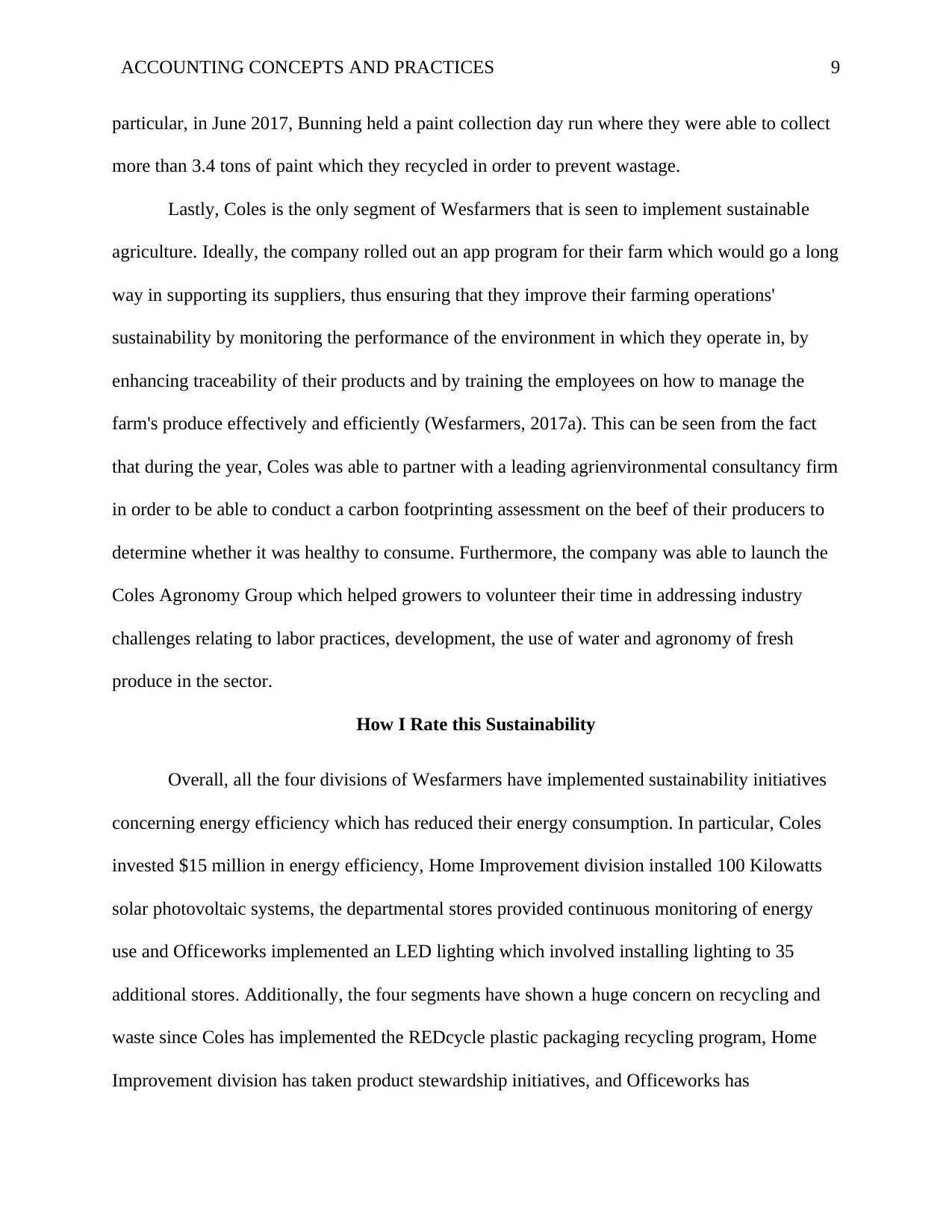
ACCOUNTING CONCEPTS AND PRACTICES 9
particular, in June 2017, Bunning held a paint collection day run where they were able to collect
more than 3.4 tons of paint which they recycled in order to prevent wastage.
Lastly, Coles is the only segment of Wesfarmers that is seen to implement sustainable
agriculture. Ideally, the company rolled out an app program for their farm which would go a long
way in supporting its suppliers, thus ensuring that they improve their farming operations'
sustainability by monitoring the performance of the environment in which they operate in, by
enhancing traceability of their products and by training the employees on how to manage the
farm's produce effectively and efficiently (Wesfarmers, 2017a). This can be seen from the fact
that during the year, Coles was able to partner with a leading agrienvironmental consultancy firm
in order to be able to conduct a carbon footprinting assessment on the beef of their producers to
determine whether it was healthy to consume. Furthermore, the company was able to launch the
Coles Agronomy Group which helped growers to volunteer their time in addressing industry
challenges relating to labor practices, development, the use of water and agronomy of fresh
produce in the sector.
How I Rate this Sustainability
Overall, all the four divisions of Wesfarmers have implemented sustainability initiatives
concerning energy efficiency which has reduced their energy consumption. In particular, Coles
invested $15 million in energy efficiency, Home Improvement division installed 100 Kilowatts
solar photovoltaic systems, the departmental stores provided continuous monitoring of energy
use and Officeworks implemented an LED lighting which involved installing lighting to 35
additional stores. Additionally, the four segments have shown a huge concern on recycling and
waste since Coles has implemented the REDcycle plastic packaging recycling program, Home
Improvement division has taken product stewardship initiatives, and Officeworks has
particular, in June 2017, Bunning held a paint collection day run where they were able to collect
more than 3.4 tons of paint which they recycled in order to prevent wastage.
Lastly, Coles is the only segment of Wesfarmers that is seen to implement sustainable
agriculture. Ideally, the company rolled out an app program for their farm which would go a long
way in supporting its suppliers, thus ensuring that they improve their farming operations'
sustainability by monitoring the performance of the environment in which they operate in, by
enhancing traceability of their products and by training the employees on how to manage the
farm's produce effectively and efficiently (Wesfarmers, 2017a). This can be seen from the fact
that during the year, Coles was able to partner with a leading agrienvironmental consultancy firm
in order to be able to conduct a carbon footprinting assessment on the beef of their producers to
determine whether it was healthy to consume. Furthermore, the company was able to launch the
Coles Agronomy Group which helped growers to volunteer their time in addressing industry
challenges relating to labor practices, development, the use of water and agronomy of fresh
produce in the sector.
How I Rate this Sustainability
Overall, all the four divisions of Wesfarmers have implemented sustainability initiatives
concerning energy efficiency which has reduced their energy consumption. In particular, Coles
invested $15 million in energy efficiency, Home Improvement division installed 100 Kilowatts
solar photovoltaic systems, the departmental stores provided continuous monitoring of energy
use and Officeworks implemented an LED lighting which involved installing lighting to 35
additional stores. Additionally, the four segments have shown a huge concern on recycling and
waste since Coles has implemented the REDcycle plastic packaging recycling program, Home
Improvement division has taken product stewardship initiatives, and Officeworks has
⊘ This is a preview!⊘
Do you want full access?
Subscribe today to unlock all pages.

Trusted by 1+ million students worldwide
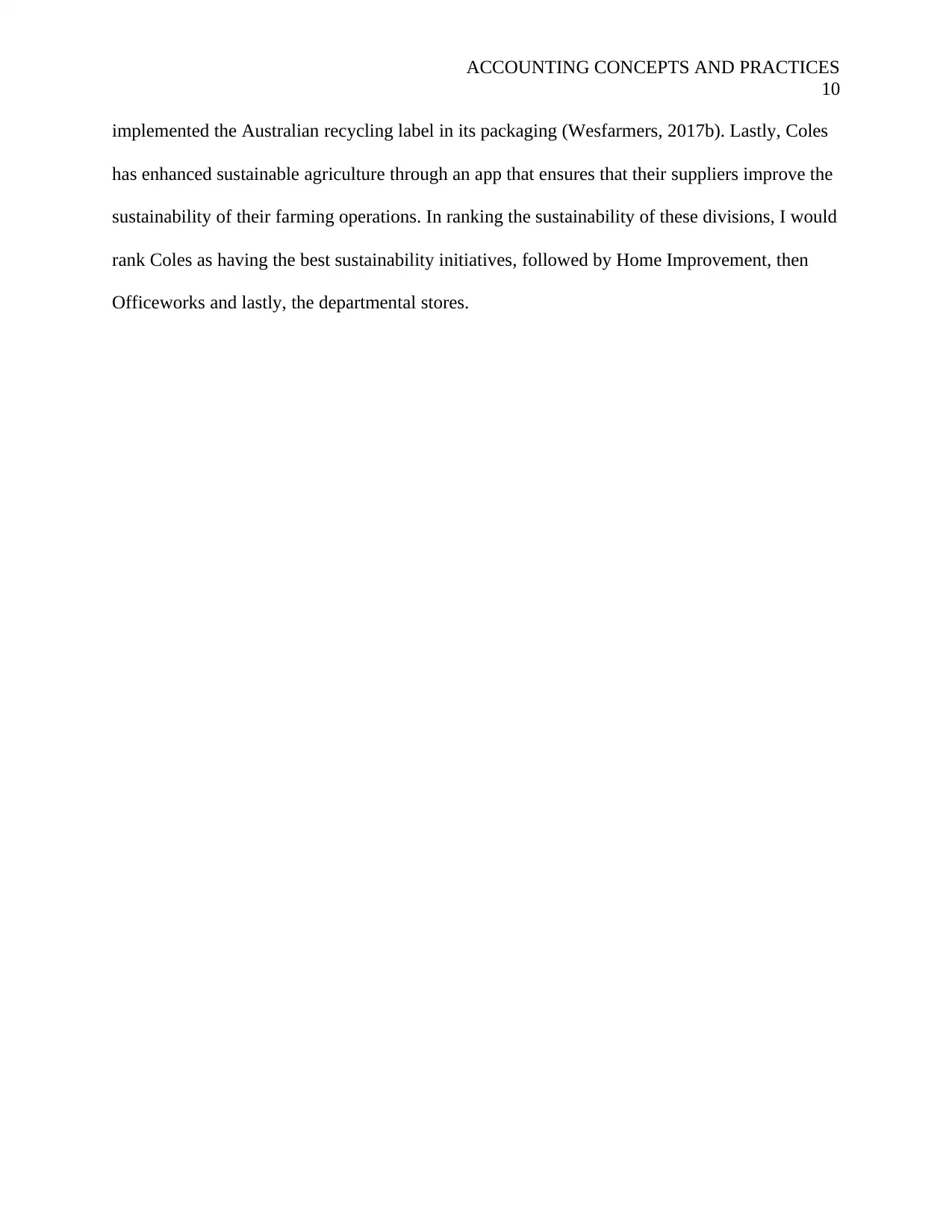
ACCOUNTING CONCEPTS AND PRACTICES
10
implemented the Australian recycling label in its packaging (Wesfarmers, 2017b). Lastly, Coles
has enhanced sustainable agriculture through an app that ensures that their suppliers improve the
sustainability of their farming operations. In ranking the sustainability of these divisions, I would
rank Coles as having the best sustainability initiatives, followed by Home Improvement, then
Officeworks and lastly, the departmental stores.
10
implemented the Australian recycling label in its packaging (Wesfarmers, 2017b). Lastly, Coles
has enhanced sustainable agriculture through an app that ensures that their suppliers improve the
sustainability of their farming operations. In ranking the sustainability of these divisions, I would
rank Coles as having the best sustainability initiatives, followed by Home Improvement, then
Officeworks and lastly, the departmental stores.
Paraphrase This Document
Need a fresh take? Get an instant paraphrase of this document with our AI Paraphraser
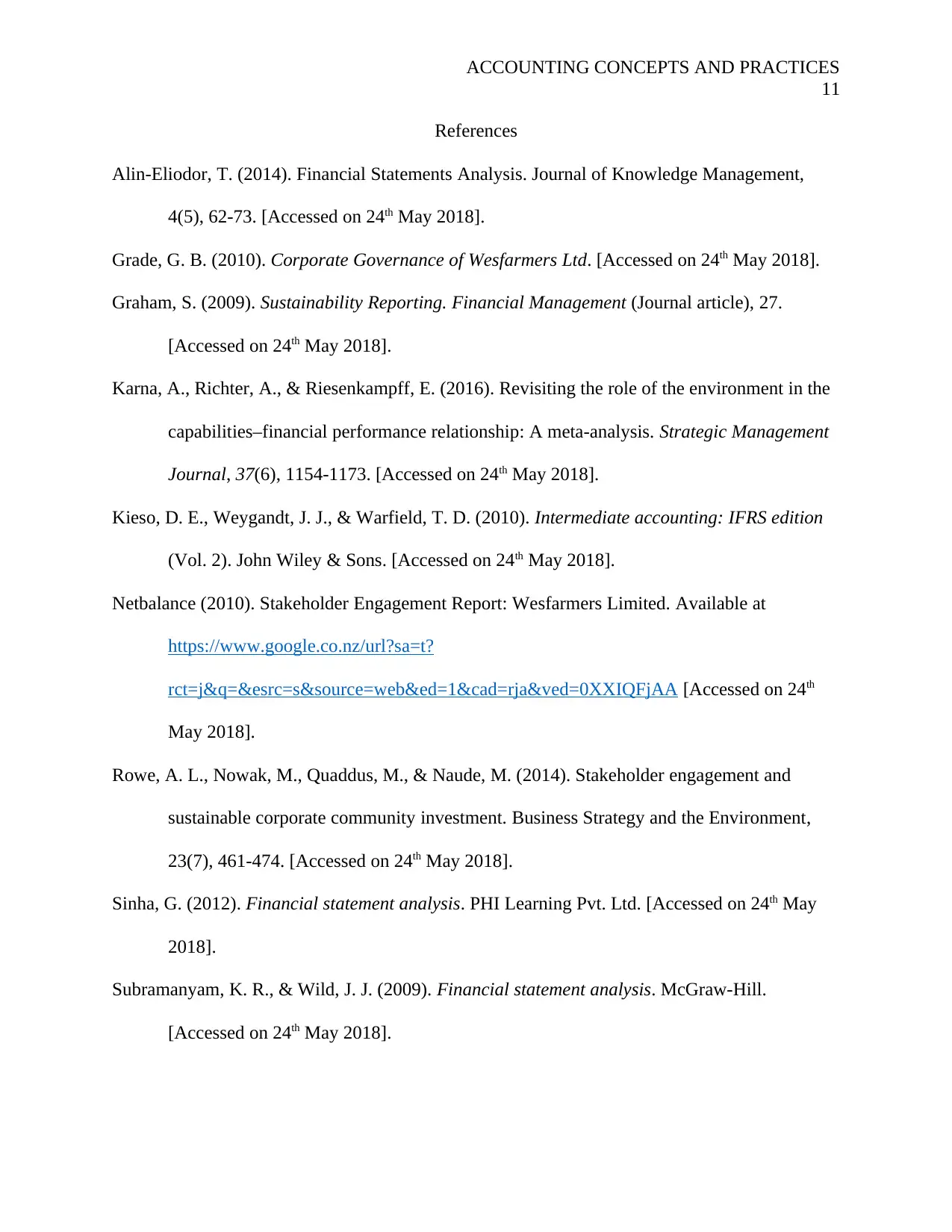
ACCOUNTING CONCEPTS AND PRACTICES
11
References
Alin-Eliodor, T. (2014). Financial Statements Analysis. Journal of Knowledge Management,
4(5), 62-73. [Accessed on 24th May 2018].
Grade, G. B. (2010). Corporate Governance of Wesfarmers Ltd. [Accessed on 24th May 2018].
Graham, S. (2009). Sustainability Reporting. Financial Management (Journal article), 27.
[Accessed on 24th May 2018].
Karna, A., Richter, A., & Riesenkampff, E. (2016). Revisiting the role of the environment in the
capabilities–financial performance relationship: A meta‐analysis. Strategic Management
Journal, 37(6), 1154-1173. [Accessed on 24th May 2018].
Kieso, D. E., Weygandt, J. J., & Warfield, T. D. (2010). Intermediate accounting: IFRS edition
(Vol. 2). John Wiley & Sons. [Accessed on 24th May 2018].
Netbalance (2010). Stakeholder Engagement Report: Wesfarmers Limited. Available at
https://www.google.co.nz/url?sa=t?
rct=j&q=&esrc=s&source=web&ed=1&cad=rja&ved=0XXIQFjAA [Accessed on 24th
May 2018].
Rowe, A. L., Nowak, M., Quaddus, M., & Naude, M. (2014). Stakeholder engagement and
sustainable corporate community investment. Business Strategy and the Environment,
23(7), 461-474. [Accessed on 24th May 2018].
Sinha, G. (2012). Financial statement analysis. PHI Learning Pvt. Ltd. [Accessed on 24th May
2018].
Subramanyam, K. R., & Wild, J. J. (2009). Financial statement analysis. McGraw-Hill.
[Accessed on 24th May 2018].
11
References
Alin-Eliodor, T. (2014). Financial Statements Analysis. Journal of Knowledge Management,
4(5), 62-73. [Accessed on 24th May 2018].
Grade, G. B. (2010). Corporate Governance of Wesfarmers Ltd. [Accessed on 24th May 2018].
Graham, S. (2009). Sustainability Reporting. Financial Management (Journal article), 27.
[Accessed on 24th May 2018].
Karna, A., Richter, A., & Riesenkampff, E. (2016). Revisiting the role of the environment in the
capabilities–financial performance relationship: A meta‐analysis. Strategic Management
Journal, 37(6), 1154-1173. [Accessed on 24th May 2018].
Kieso, D. E., Weygandt, J. J., & Warfield, T. D. (2010). Intermediate accounting: IFRS edition
(Vol. 2). John Wiley & Sons. [Accessed on 24th May 2018].
Netbalance (2010). Stakeholder Engagement Report: Wesfarmers Limited. Available at
https://www.google.co.nz/url?sa=t?
rct=j&q=&esrc=s&source=web&ed=1&cad=rja&ved=0XXIQFjAA [Accessed on 24th
May 2018].
Rowe, A. L., Nowak, M., Quaddus, M., & Naude, M. (2014). Stakeholder engagement and
sustainable corporate community investment. Business Strategy and the Environment,
23(7), 461-474. [Accessed on 24th May 2018].
Sinha, G. (2012). Financial statement analysis. PHI Learning Pvt. Ltd. [Accessed on 24th May
2018].
Subramanyam, K. R., & Wild, J. J. (2009). Financial statement analysis. McGraw-Hill.
[Accessed on 24th May 2018].
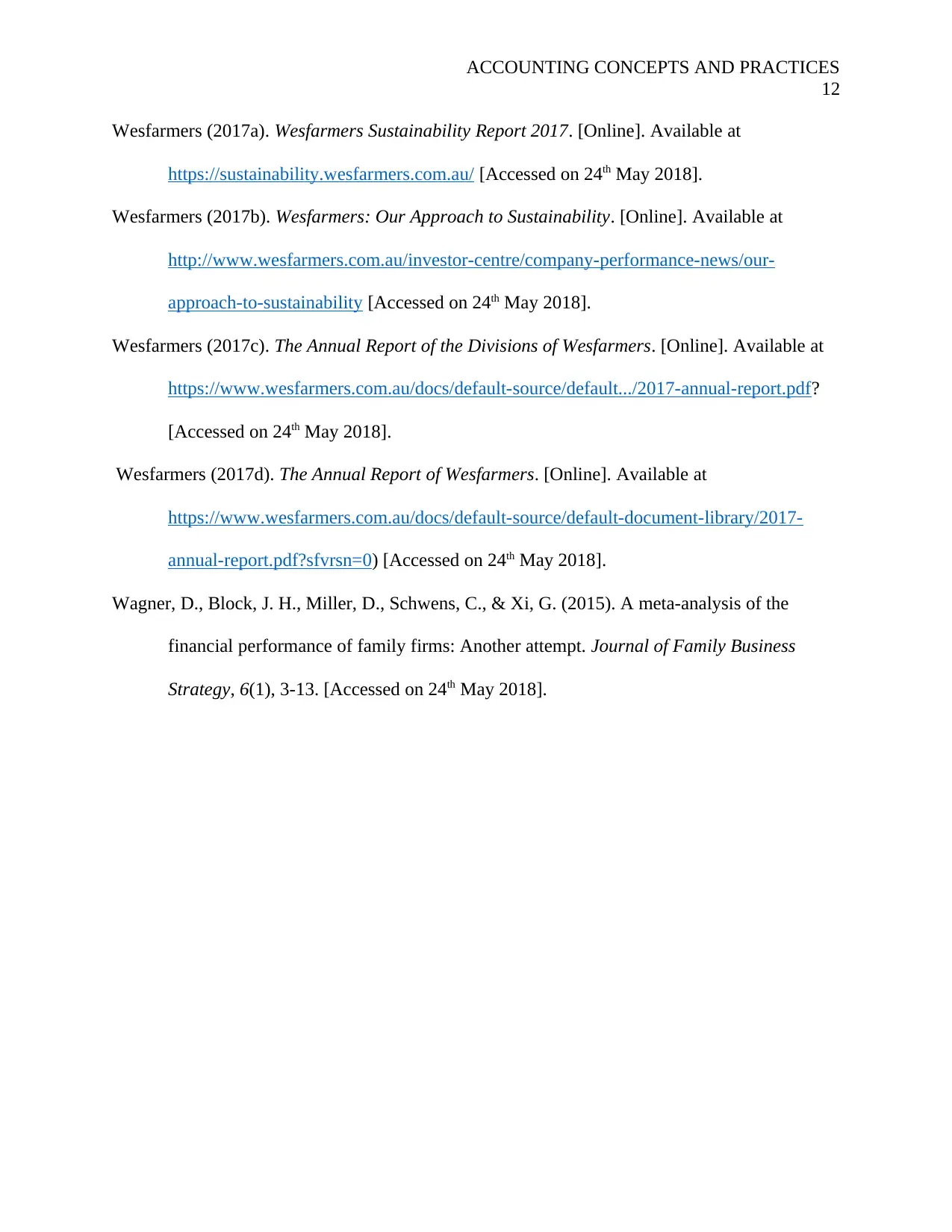
ACCOUNTING CONCEPTS AND PRACTICES
12
Wesfarmers (2017a). Wesfarmers Sustainability Report 2017. [Online]. Available at
https://sustainability.wesfarmers.com.au/ [Accessed on 24th May 2018].
Wesfarmers (2017b). Wesfarmers: Our Approach to Sustainability. [Online]. Available at
http://www.wesfarmers.com.au/investor-centre/company-performance-news/our-
approach-to-sustainability [Accessed on 24th May 2018].
Wesfarmers (2017c). The Annual Report of the Divisions of Wesfarmers. [Online]. Available at
https://www.wesfarmers.com.au/docs/default-source/default.../2017-annual-report.pdf?
[Accessed on 24th May 2018].
Wesfarmers (2017d). The Annual Report of Wesfarmers. [Online]. Available at
https://www.wesfarmers.com.au/docs/default-source/default-document-library/2017-
annual-report.pdf?sfvrsn=0) [Accessed on 24th May 2018].
Wagner, D., Block, J. H., Miller, D., Schwens, C., & Xi, G. (2015). A meta-analysis of the
financial performance of family firms: Another attempt. Journal of Family Business
Strategy, 6(1), 3-13. [Accessed on 24th May 2018].
12
Wesfarmers (2017a). Wesfarmers Sustainability Report 2017. [Online]. Available at
https://sustainability.wesfarmers.com.au/ [Accessed on 24th May 2018].
Wesfarmers (2017b). Wesfarmers: Our Approach to Sustainability. [Online]. Available at
http://www.wesfarmers.com.au/investor-centre/company-performance-news/our-
approach-to-sustainability [Accessed on 24th May 2018].
Wesfarmers (2017c). The Annual Report of the Divisions of Wesfarmers. [Online]. Available at
https://www.wesfarmers.com.au/docs/default-source/default.../2017-annual-report.pdf?
[Accessed on 24th May 2018].
Wesfarmers (2017d). The Annual Report of Wesfarmers. [Online]. Available at
https://www.wesfarmers.com.au/docs/default-source/default-document-library/2017-
annual-report.pdf?sfvrsn=0) [Accessed on 24th May 2018].
Wagner, D., Block, J. H., Miller, D., Schwens, C., & Xi, G. (2015). A meta-analysis of the
financial performance of family firms: Another attempt. Journal of Family Business
Strategy, 6(1), 3-13. [Accessed on 24th May 2018].
⊘ This is a preview!⊘
Do you want full access?
Subscribe today to unlock all pages.

Trusted by 1+ million students worldwide
1 out of 12
Related Documents
Your All-in-One AI-Powered Toolkit for Academic Success.
+13062052269
info@desklib.com
Available 24*7 on WhatsApp / Email
![[object Object]](/_next/static/media/star-bottom.7253800d.svg)
Unlock your academic potential
Copyright © 2020–2026 A2Z Services. All Rights Reserved. Developed and managed by ZUCOL.



